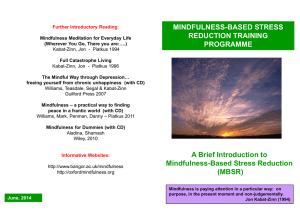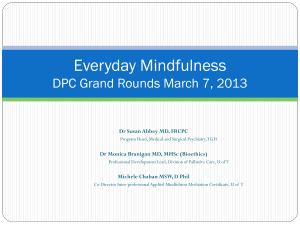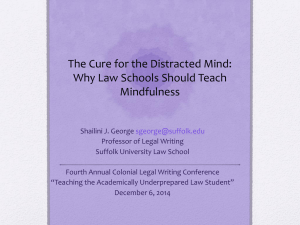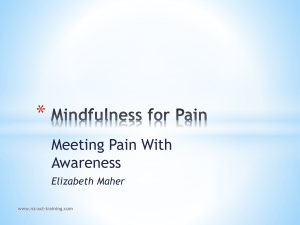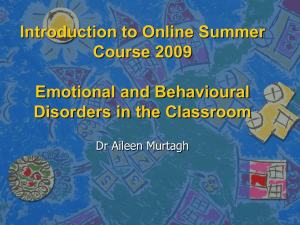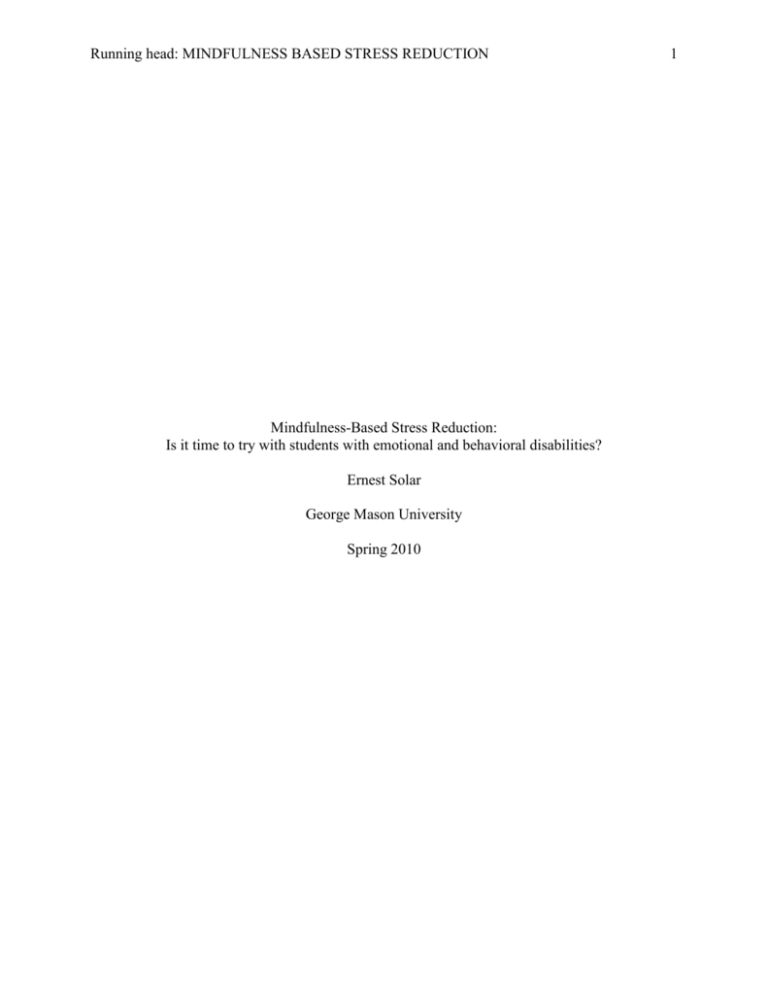
Running head: MINDFULNESS BASED STRESS REDUCTION
Mindfulness-Based Stress Reduction:
Is it time to try with students with emotional and behavioral disabilities?
Ernest Solar
George Mason University
Spring 2010
1
MINDFULNESS BASED STRESS REDUCTION
2
Mindfulness Based Stress Reduction:
Is it time to try with students with emotional and behavioral disabilities?
Conservative estimates from educators and mental health professionals indicate that
approximately 10% of school-aged children experience emotional and behavioral problems that
are serious enough to require professional attention (Kauffman, 2005). Many of these students
are identified in schools and receive special education services due to their emotional or
behavioral disability. The Individuals with Disabilities Education Act (IDEA) defines an
emotional or behavioral disorder (disability) (EBD) as at least one defined characteristic
exhibited over a long period of time that adversely affects a child’s educational performance.
The defined characteristics outlined in IDEA are: (a) an inability to learn that cannot be
explained by intellectual, sensory, or health factors; (b) an inability to build or maintain
satisfactory interpersonal relationships with peers and teachers; (c) inappropriate types of
behavior or feelings under normal circumstances; (d) a general pervasive mood of unhappiness
or depression; (e) a tendency to develop physical symptoms or fears associated with personal or
school problems (Bartick-Ericson, 2006; Kauffman, 2005; U.S. Department of Education, 1998).
According to the U.S. Department of Education (2010) more than 442,000 students
between the ages of 6 and 21, in 2007-08, received special education services related to (EBD).
Of those students identified with EBD, 81% of those students participate in some portion of
general education classes in regular public schools, while receiving behavior supports and
academic accommodations. The number of students with EBD being served in public schools
has increased by 64% since 1976-77; however, specific learning disabilities, other health
impairments, and autism have also increased significantly over the past thirty years; which can
be attributed to many of the federal statutes that have been passed during that timeframe. In
consequence, the increased percentage of students with disabilities being served has created a
MINDFULNESS BASED STRESS REDUCTION
3
strain on the public school systems to serve these student populations. This is evident by the
increase in the number of emergency and provisional special education licenses distributed
throughout the country (Bullock & Gable, 2006).
With regards to students with EBD, over the past fifty years several advocacy
organizations have come into existences to provide support for students, families, teachers, and
administrators that work with these students. Two of these major organizations are the Council
for Exceptional Children (CEC) and the subdivision, Council for Children with Behavioral
Disorders. Both of these organizations have been instrumental in advocating and assisting
legislators in crafting laws that protect and support the needs of students with EBD. Besides
national organizations the federal government has also completed several longitudinal studies
that have helped to identify characteristics and outcomes of students with EBD.
The National Longitudinal Transition Study-2 (NLTS2) and the National Adolescent and
Child Treatment Study (NACTS) have acted as baseline data for educators and researchers to
develop evidence-based practices that could potentially assist students with EBD. The current
research and organizations, such as CEC, outline evidence-based practices that are effective for
students with EBD. Unfortunately, as pointed out by these surveys students with EBD still have
a difficult time performing successfully in school environments. In Bradley, Doolittle, and
Bartolotta (2008) literature review, they pointed out that these studies have also shown that only
small gains have been made for these students in regards to academic achievement, social
behavior, and long-term adult success. Therefore, the question needs to be asked, is it time to try
a different approach?
Due to the overwhelming number of interventions used with students with EBD, this
paper will briefly highlight, (a) current international interventions, (b) the effectiveness of social
MINDFULNESS BASED STRESS REDUCTION
4
skills training with secondary students with EBD, (c) the effects of meditation and relaxation
techniques on students with anxiety related to their behaviors and academic performance, and (d)
the importance of teacher preparedness. Lastly, this paper will also examine the possibility of
incorporating an alternative approach to managing students with EBD through the use of a
medically proven therapy known at Mindfulness Based Stress Reduction (MBSR).
Emotional and Behavior Disability Interventions
Students with EBD are a concern for school systems and educators in America, but also
around the world. The United Kingdom, Australia, Canada, and Latin America all report a
growing concern for students with emotional or behavioral problems. In 2007, Gulchak and
Lopes completed a meta-analysis on research-based interventions on an international scale.
They found that research-based interventions predominately come from the United States.
Gulchak and Lopes (2007) also summarized research-based interventions that are commonly
used in the United States. These interventions included; (a) positive reinforcement, (b) student
participation, (c) positive behavior supports (PBS) and functional behavioral assessments (FBA),
(d) social skills instruction, (e) self-management, (f) school-wide systems of positive behavior
support (SW-PBS), and (g) token economies. This is by no means a comprehensive list of the
multitude of interventions used on a daily basis in the classroom, but it is a good representation
of what educators in the United States use to help students with EBD.
In Gulchak and Lopes (2007) international meta-analysis they only found eight
interventions using a quantitative design treatment to measure the effects of the interventions.
Of those eight studies; (a) three used a form of psychotherapy, massage, and holistic
interventions, (b) three studies used social skills training, (c) one study assessed language and
communication skills, (d) and the last study employed direct observation of displayed behaviors.
MINDFULNESS BASED STRESS REDUCTION
5
Through their analysis, Gulchak and Lopes (2007) found that other countries based behavior
interventions on the use of holistic and therapeutic treatments to change undesirable behaviors.
While the United States uses more of an analytic approach with the use of functional behavior
assessments, applied behavior analysis, and positive behavior support plans.
Cook, Gresham, Kern, Barrera, Thornton, and Crews (2008) completed a “megaanalysis” (2008, p. 134) of five meta-analyses related to social skills training (SST) for
secondary students with EBD. The five meta-analyses used in their review contained “77
studies, which involved approximately 5,000 student participants” (2008, p. 137). Through their
analysis they found that SST is an effective intervention tool with an effect size of r = .32, which
falls in the medium effect range, which in turn means a change in behavior could be seen in
everyday life. They also found that the internal and external validity of SST has an effect size of
r = .32, which indicates that the changes in behavior displayed by the participants is related to
the SST and the results can be generalized beyond the conditions of the research study.
Students with EBD are a multi-faceted group of individuals with an array of
dysfunctional behavioral, social, and academic skills. One student may benefit from SST, but
another student may have such severe anxiety that their social and academic performance
diminishes due to their level of stress (Schoenfeld & Janney, 2008; Epply, Abrams, and Shear,
1989). Eppley et al. (1989) completed a meta-analysis of relaxation techniques used to reduce
the effects of stress and improving overall health. Through their analysis they examined 110
studies with non-psychiatric patients who had never experienced relaxation or meditation
practices and found the following effect sizes: (a) progressive relaxation, r = .38, and (b)
Transcendental meditation, r = .70. Even though the study is out-dated, the findings are still
relevant due to the high effect size of using a meditative practice to reduce the effects of anxiety.
MINDFULNESS BASED STRESS REDUCTION
6
Both the Cook et al. and Eppley et al. studies outline positive effects in helping students
with disabilities. However, there is a still a large concern that schools are having a difficult time
implementing adequate supports for students with EBD (Bullock & Gable, 2006). Bullock and
Gable acknowledge that a large array of research-based interventions have been developed to
help students with EBD if they are used appropriately; however, “the ultimate goal is to teach the
students skills that will enable them to regulate their own behavior” (p. 9). Through
mindfulness-based stress reduction all age groups can learn how to regulate their own behavior,
which would complement many of the research-based interventions being used in schools to help
students with EBD.
Mindfulness-Based Stress Reduction: Current research-based practices
Mindfulness-Based Stress Reduction (MBSR) is a structured meditation practice that is
used in the medical and health care field to reduce stress, increase relaxation, elevate pain, and
improve self-esteem (“Stress Reduction Program”, n.d.). Over the past thirty-years MBSR has
been researched by the medical and health care community to document its many positive effects
patients experience. For example, a clinical study showed a reduction in anxiety and depression
in patients who engaged in a MBSR program (Miller, Fletcher, & Kabat-Zinn, 1995). Another
study showed positive results in 174 patients who engaged in a MBSR program in reducing
stress-related problems, anxiety, and chronic pain (Carmody and Baer, 2008). Reibel, Greeson,
Brainard, and Rosenzweig (2001) reported a 44% reduction of anxiety and 34% reduction of
depression in 136 heterogeneous patients. Barnes, Bauza, and Treiber (2001) used a similar
meditation program with inner-city African-American adolescents between the ages of 15 to 18
years old and found lower rates in absenteeism and school suspensions in the population of
students engaged in a meditation program. Lastly, Agee, Danoff-Burg, & Grant study (2009)
MINDFULNESS BASED STRESS REDUCTION
7
there was a 94.7% completion rate of the mindfulness meditation intervention among
participants. This is comparable to completion rates of similar MBSR programs, which the
researchers feel confirms that the intervention is accepted by participants.
In 2005, the Garrison Institute released the Garrison Institute Report on Contemplation
and Education; which was a survey of contemplative practices used in K-12 educational settings.
This report defines contemplation practices as meditation practices that are not related to
religious organizations. The report organized programs into two categories: contemplative
programs or contemplative techniques. In defining a contemplative program, the Garrison
Report based its definition on the structure of the MBSR program. A contemplative program
specifically emphasizes mindfulness and improving a students’ capacity for self-awareness.
Contemplative techniques use methods (not related to a program) that include teaching students
how to pay better attention. The report outlined sixteen contemplation programs, seventeen
programs that use contemplation techniques, and five teacher training programs that train
teachers to use contemplation in the education system.
The Garrison Report (2005) equates that the MBSR model is appropriate for educational
settings by stating, “whereas pain and stress can be symptomatic of disease, trauma or other
health-related causes, academic failure and anti-social behaviors at school often indicate
systemic problems within the school community” (p. 7). The Center for Mindfulness at the
University of Massachusetts Medical School “believes that students, teachers and other members
of the school community can benefit from mindfulness and other contemplative techniques in an
effort to become more responsive and less reactive, more focused and less distracted, more calm
and less stressed” (Garrison Institute, 2005, p. 7-8). The assumption of these statements is if
teachers, administrators, school staff, and students incorporate MBSR practices and principles
MINDFULNESS BASED STRESS REDUCTION
8
the school community in general will be calmer, less distracted, and respond more appropriate to
each other. In essence, it would create a better and more efficient learning and working
environment for everyone.
Conclusion
Bradley et al (2008) summarized from the NLTS2 that early intervention and prevention
programs show promise for improving student behavior; however, as students with EBD move
through the school system their behavioral, social, and academic deficits become increasingly
resistant to interventions. Furthermore, school systems are interested in reducing negative school
behaviors, but they have a difficult time identifying programs that are effective and easy to
implement on a broad scale in the classroom or school environment that will bring about the
change they desire (Everett, Kann, & McReynolds, 1997). One approach to the growing
problem of school-related conduct and behavior problems may be to provide training in stress
reduction. (Barnes, Bauza, & Treiber, 2003).
The medical and psychiatric research communities have documented the effectiveness of
MBSR interventions in various heterogeneous and homogenous populations. The research has
been conducted across a multitude of medical, psychiatric, and healthy populations, related to
stress, behavior, and anxiety disorders, and have consistently shown positive effects in helping
individuals with stress and anxiety related disorders. The research has also shown that MBSR is
well-received by participants and has a high completion rate.
Dr. Sibinga (personal communication, July 20, 2010) has developed a model that shows
how mindfulness training can improve the appraisal and coping mechanisms, reflection, and selfregulation processes; in order to positively change a person’s psychological symptoms, mood
states, and interpersonal functioning (Figure 1). This model is supported by Reibel et al.’s
MINDFULNESS BASED STRESS REDUCTION
9
findings that MBSR contains therapeutic elements that improve the physical and mental health of
participants.
Maybe the time has come for a paradigm shift in how schools provide interventions to
students with EBD, and switch to a therapeutic application of MBSR in school and classroom
settings. The Garrison Report (2005) and medical research has shown, MBSR is becoming more
prevalent in educational, medical, and therapeutic settings as a successful intervention in helping
all different types of individuals across various age groups. Gulchak and Lopes (2007) have also
shown the difference between United States interventions and international interventions in the
respect that other countries have shown effective results in the use of therapeutic strategies in
helping students with EBD.
It is clear that more research needs to be conducted in school settings with general
education and special education students in the use of MBSR practices. However, there is
enough research to suggest that MBSR can be used as an extension of self-management
interventions, which would empower students to control their own behaviors in an academic
setting (King-Sears, 2006).
MINDFULNESS BASED STRESS REDUCTION
10
References
Agee, J., Danoff-Burg, S., & Grant, C. (2009). Comparing brief stress management courses in a
community sample: Mindfulness skills and progressive muscle relaxation. Explore, 5(2),
104-109.
Barnes, V., Bauza, L., & Treiber, F. (2003). Impact of stress reduction on negative school
behavior in adolescents. Health and Quality of Life Outcomes, 1(10), 1-7.
Bartick-Ericson, C. (2006). Attachment security and the school experience for emotionally
disturbed adolescents in special education. Emotional and Behavioral Difficulties, 11(1),
49-60.
Bradley, R., Doolittle, J., & Bartolotta, R. (2008). Building on the data and adding to the
discussion: The experiences and outcomes of students with emotional disturbance.
Journal of Behavioral Education, 17, 4-23.
Bullock, L. & Gable, R. (2006). Program for children and adolescents with emotional and
behavioral disorders in the united states: A historical overview, current perspectives, and
future directions. Preventing School Failure, 50(2), 7-13.
Carmody, J. & Baer, R. (2008). Relationship between mindfulness practice and levels of
mindfulness, medical and psychological symptoms and well-being in a mindfulnessbased stress reduction program. Journal of Behavioral Medicine, 31, 23-33.
Cook, C., Gresham, F., Kern, L., Barreras, R., Thornton, S., & Crews, S. (2008). Social skills
training for secondary students with emotional and/or behavioral disorders: A review and
analysis of the meta-analytic literature. Journal of Emotional and Behavioral Disorders,
16(3), 131-144.
MINDFULNESS BASED STRESS REDUCTION
11
Eppley, K., Abrams, A., & Shear, J. (1989). Differential effects of relaxation techniques on trait
anxiety: A meta-analysis. Journal of Clinical Psychology, 45(6), 957-974.
Everett, S., Kann, L., & McReynolds, L. (1997). The youth risk behavior surveillance system:
Policy and program applications. Journal of School Health, 67(8), 333-335.
Garrison Institute. (2005). Garrison institute report: Contemplation and education: A survey of
programs using contemplative techniques in K-12 educational settings: A mapping
report. New York: Garrison Institute.
Gulchak, D. & Lopes, J. (2007). Interventions for students with behavioral disorders: An international
literature review. Behavioral Disorders, 32(4), 267-281.
Hart, T. (2004). Opening the contemplative mind in the classroom. Journal of Transformative Education,
2(1), 28-46.
Kauffman, J. (2005). Characteristics of emotional and behavioral disorders of children and
youth (8th ed.). Upper Saddle River, NJ. Pearson Prentice Hall.
King-Sears, M. (2006). Self-management for students with disabilities: The importance of teacher followup. International Journal of Special Education, 21(2), 94-108.
Miller, J., Fletcher, K., & Kabat-Zinn, J. (1995). Three-year follow-up and clinical implications of a
mindfulness meditation-based stressed reduction intervention in the treatment of anxiety
disorders. General Hospital Psychiatry, 17, 192-200.
Reibel, D., Greeson, J., Brainard, G., & Rosenzweig, S. (2001). Mindfulness-based stress reduction and
health-related quality of life in a heterogeneous patient population. General Hospital Psychiatry,
23, 183-192.
Rosenzeig, S., Reibel, D., Greeson, J., Brainard, G., & Hojat, M. (2003). Mindfulness-based stress
reduction lowers psychological distress in medical students. Teaching and Learning in Medicine,
15(2), 88-92.
MINDFULNESS BASED STRESS REDUCTION
12
Schoenfeld, N. & Janney, D. (2008). Identification and treatment of anxiety in students with emotional or
behavioral disorders: A review of the literature. Education and Treatment of Children, 31(4),
583-610.
Stress reduction program (n.d.). Retrieved from http://www.umassmed.edu/
uploadedFiles/cfm2/SRP_for_desktop_printing.pdf
U.S. Department of Education. (1998). Twentieth annual report to Congress on the
implementation of the Individuals with Disabilities Education Act. Washington, DC:
Author.
U.S. Department of Education, National Center for Education Statistics (2010). Digest of
Education Statistics, 2009 (NCES 2010-013), Chapter 2. Retrieved from
http://nces.ed.gov/fastfacts/display.asp?id=64
MINDFULNESS BASED STRESS REDUCTION
Figure 1: Sibinga’s Mindfulness Model
Mindfulness
Appraisal, Coping, & SelfRegulatory Processes
Improved appraisal and
coping mechanisms
Increased reflection
Enhanced self-regulation
Psychological & Interpersonal
Functioning
Psychological
symptomatology
Mood states
Interpersonal functioning
13


